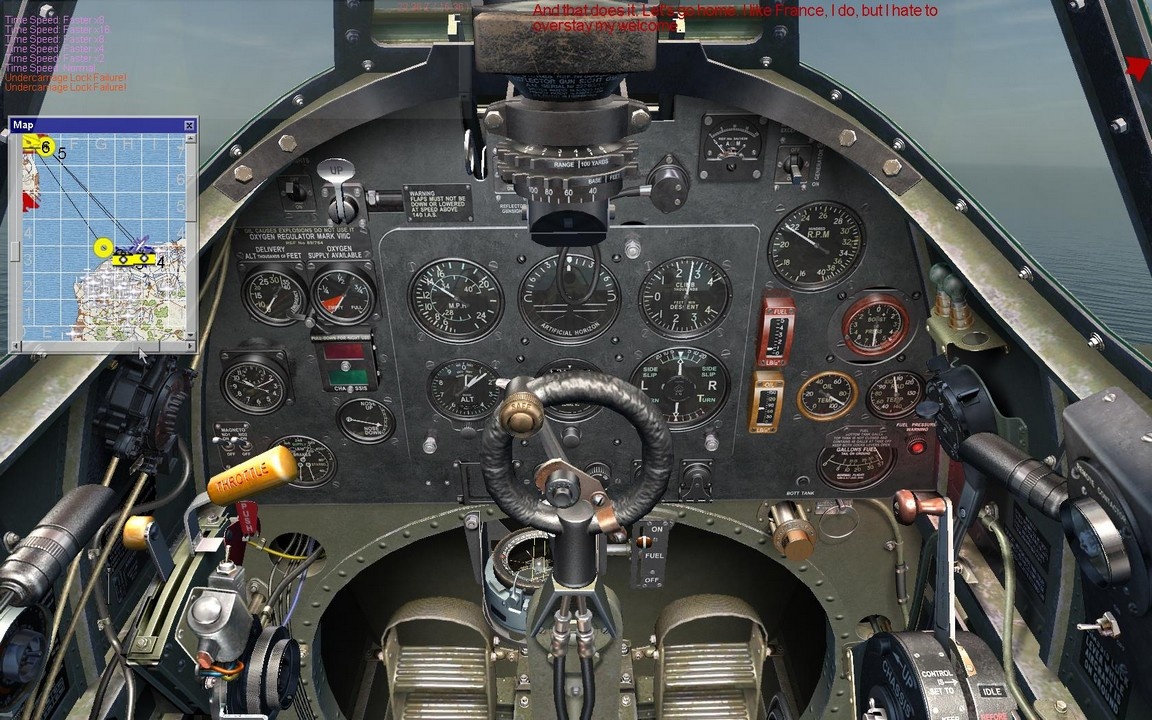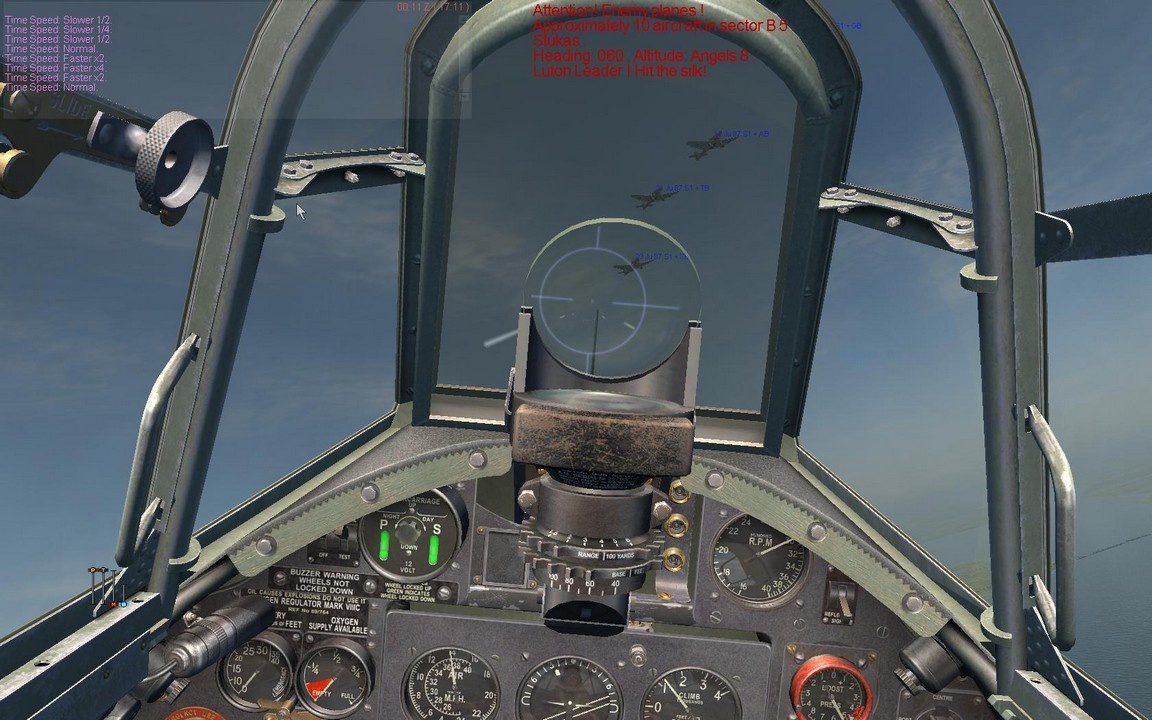When a once-popular genre goes underrepresented for so long, it's tempting to give any new entry the benefit of the doubt. That's especially true when that new product comes from a developer known for its dedication to the subject matter. IL-2 Sturmovik: Cliffs of Dover is one such game, and Maddox Games is one such developer. What to make, then, of this unfinished fiasco, especially when its target audience has so few modern options? Like previous IL-2 installments, this World War II combat flight simulator will benefit from a passionate community and the included modification tools. But that's no excuse for the clearly broken state it was released in. The technical issues are a real shame, for underneath them is a solid and complex simulation that deserved a worthy package to showcase it. In time, Cliffs of Dover might soar. But for now, all but the most patient simmers should leave this damaged aircraft in the hangar for further maintenance.
That something is wrong with Cliffs of Dover is clear from the moment you boot it up and the grating, synthesized fanfare struggles to play, sometimes going silent, other times starting only when you click on various menu options. Once you're in the cockpit, your initial fears won't be unfounded: Cliffs of Dover struggles to maintain a smooth frame rate on machines exceeding the recommended specifications. You can fiddle with the in-game settings, but doing so doesn't always have the drastic effect you might expect, and it might cause unforeseen side effects that should have been noticed and fixed. For example, if you play the tutorial missions on low settings, you can't see the yellow rings you're supposed to fly through. The sudden jitters, drops into single-digit frame rates, and overall choppiness aren't just annoyances: they make the game unenjoyable, at times bordering on unplayable.
Of course, many outstanding PC games have required beefy rigs to get the most out of them, but you generally expect technical struggles to come with an obvious benefit: gorgeous visuals. IL-2's cockpits look phenomenal, and the waters of the English Channel undulate authentically underneath your roaring Spitfire. Most everything else looks just so-so, from canned explosions, to low-fidelity ground textures, to bland buildings. The older Wings of Prey was not a proper simulation, but it set a high bar for flight game graphics using the IL-2 Sturmovik graphics engine, ironically enough. Cliffs of Dover is nowhere near that level of beauty, which makes the chugging even harder to stomach. It's easy to admire how shadows roam across the cockpit if you manage to run the game at higher settings and the way bullets shatter your windshield and leave holes in your wings. (This series' damage modeling has always been terrific.) But it all seems so meaningless when you fly above a relatively bland-looking London or a garish green-yellow countryside, only for the game to turn into a slide show.

That aforementioned damage model isn't just cosmetic: enemy bullets can puncture vital mechanisms (or if you have bombs at the ready, do something more immediately dramatic), though they are hardly the only factor in how your aircraft handles. Make no mistake: this is the real deal. If you are a dedicated simmer, you will appreciate the attention to detail in the way airplanes feel in the air and react to your actions. Crank up the realism options, and just getting off the ground is as daunting and rewarding as you might expect. A full takeoff procedure is emulated here on these settings, so you need to consider fuel mixture, open radiators, turn on magnetos, adjust prop pitch, and so on. Once you're in the air, vibration might indicate bad pitch, and failure to manage your systems can result in leaks and blown gaskets. (Having your windshield splattered with black goo is always a terrifying sign.) Sim fans will adore this kind of detail, though even they will note some obvious bugs and flaws. For example, you can pull up a menu for communicating to your wingmen, but the options don't actually work. Thus, you may come in for a successful landing, and then have your wingmen crash into you.
If you are new to flight sims, Cliffs of Dover lets you tailor your experience, though you have to jump through a lot of hoops regardless. The useless tutorial missions gloss over too much basic information to make them helpful for new pilots, so neophytes will need to study the manual and adjust controls in the in-game menus before feeling comfortable in the sky. (You absolutely need a joystick to get the most out of this game.) Fortunately for those folks, you can tweak realism settings in any number of ways, so if you are frightened by the prospects of full takeoff and landing procedures, you can avoid those steps altogether. Or better yet, choose the option that lets you start your engine(s) with a single keystroke. You might also engage the autopilot on long stretches and crank up the game speed, turn on the eyesore icons that identify friendlies and enemies, and even turn off stalls and spins. You couldn't call IL-2 Sturmovik: Cliffs of Dover friendly, exactly, but after the initial curve, there are plenty of ways to tailor the experience to your skill level.
Regardless of your skill, Cliffs of Dover, like most such games, can be tense and exciting. Dogfights and bombing runs aren't a thrill a minute, but they capture the sensation that anything can happen--and sometimes does. Roaring toward an enemy fighter in your Spitfire and filling it with holes is always rewarding. Firing your cannons causes your Messerschmitt to shake ominously, and watching your target spiral toward the sea is always a treat. Success takes patience; an overly steep climb could cause a stall, and banking too hard could send you into a spin or dive. It's a challenge to recover control in such cases, but proper use of the rudder can pull you out of a sticky situation, making such recoveries a relief. Dogfights are just as much about knowing your aircraft as they are about shooting down your foes--and that's what makes downing the pilot you're dogging so enjoyable. Triumphing is sweet, because you had to work hard for it: you aren't just shooting down one plane after another like some kind of otherworldly hero. Unfortunately, the statistics screen is busted, so don't look there if you want to pat yourself on the back for your remarkable skills.

Cliffs of Dover thus creates an atmosphere of wartime dread, though the sound design has a tendency to undermine the authenticity. The smooth growl of the Messerchmitt sounds fine, but other aspects of the audio sound clearly synthesized, and some noises sound as if they were sampled from lawnmowers rather than enormous airplane engines. Cannons sound more like bongo drums than they do actual cannons, and some glitches are overly obvious (the scraping noise that continues to play after a crash landing, for example). In any case, the disappointing sound doesn't fully break your immersion, and Cliffs of Dover, when it's running properly, gives you a great sense of being in an actual cockpit. The tension levels increase further when you take the game online, though this is an arena best left to experienced pilots--and those who can get past the frame rate problems and other issues that interfere with multiplayer competition. The game reportedly supports dozens upon dozens of players participating in persistent battles that could rage for hours, days, and even weeks, though you won't find such an experience in its current state. Should you find a multiplayer server, it's intimidating and rewarding to fight online, provided the visual stutters don't greatly hamper the experience. But that requires getting past the unintuitive interface, the slow server browser, the lack of dedicated server documentation, and plenty more.
Cliffs of Dover contains two campaigns, the first of which tells the tale of a Royal Air Force pilot struggling not just with his aircraft, but also with his fellow pilots. All storytelling is delivered between missions in a scrolling text window. The briefings lack proper punctuation and feature plenty of grammar errors, but they're descriptive enough to make you want to see where the story might lead. But the RAF campaign is such a mess that it leads only to heartache. Mission objectives are often unclear, and you might fail them even if it seems you complete what the briefing asks of you. Not that failing a mission hinders you: you can continue to the next one regardless of what happens. There are sometimes hilarious disconnects between your actions and those described in the update that follows. For example, one mission has you in the cockpit of a new aircraft for the first time. Your ensuing flight might be flawless, but your superior officer condemns your performance anyway. In another mission, a fellow pilot makes threats that he never attempts to follow through on, and ignores the actions you take in the air, even though the story sets up a very different scenario. To make matters worse, the campaign comes to an abrupt end just when the plot gets interesting; there is no conclusion, and several story threads are left hanging without resolution. Either the campaign wasn't finished or a game-stopping bug brings it to an unintended end.

The RAF campaign's fragile state is seen throughout its presentation, from the way the story boxes start with the scroll bar set to the middle, forcing you to scroll up every time, to the inability to replay these missions once you complete them, to the unintuitive way the menus usher you from one mission to the next. These issues also occur in the second campaign, which is split into three parts and has you fighting for the Luftwaffe in such aircraft as the Ju-87 Stuka. You also encounter mission failures here without ever knowing exactly how you could have avoided them, but this is where history buffs may find the most pleasure in Cliffs of Dover: reenacting historical battles and discovering how the actions they take in the air compare to actual events. You can also take part in stand-alone missions that may involve something as simple as a London sightseeing tour, or a bomber intercept with a lot more action.
Cliffs of Dover doesn't possess the plethora of content that the highly superior and feature-rich IL-2 Sturmovik: 1946 does, though to be fair, that game is the work of years of additional content and fixes applied to the original IL-2 Sturmovik. Nevertheless, Cliffs of Dover is so decrepit that there's no legitimate reason to leave 1946 behind for the new entry, as tempting as it might be to support it. Enthusiasts will likely use the included mission builder and their own talents to fix existing problems and add wonderful new content in the months to come, but that's no excuse for what IL-2 Sturmovik: Cliffs of Dover is now: a solid simulation delivered in a package unfit for consumers.